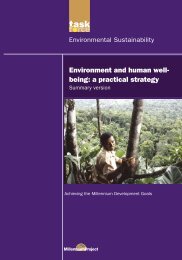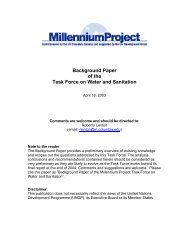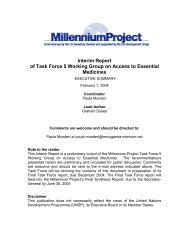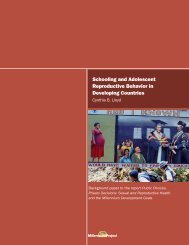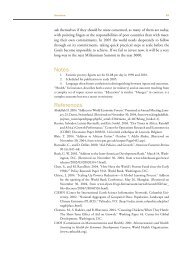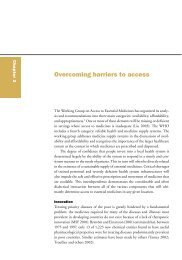the challenges facing landlocked developing countries: a case study ...
the challenges facing landlocked developing countries: a case study ...
the challenges facing landlocked developing countries: a case study ...
Create successful ePaper yourself
Turn your PDF publications into a flip-book with our unique Google optimized e-Paper software.
EXECUTIVE SUMMARY<br />
The Human Development Report 2002 (HDR) paints a stark picture for most of <strong>the</strong><br />
world’s <strong>landlocked</strong> <strong>countries</strong>. None of <strong>the</strong> non-European <strong>landlocked</strong> <strong>countries</strong> are<br />
classified as “high human development;” thirteen <strong>landlocked</strong> <strong>countries</strong> are classified as<br />
“low human development,” and nine of <strong>the</strong> world’s twelve least developed <strong>countries</strong> are<br />
<strong>landlocked</strong>.<br />
Although geographic location is just one of many factors contributing to economic and<br />
human development, <strong>the</strong>se summary indicators from <strong>the</strong> HDR highlight <strong>the</strong> difficult<br />
situation faced by so many <strong>landlocked</strong> <strong>countries</strong>. The most obvious challenge <strong>landlocked</strong><br />
<strong>countries</strong> encounter relative to <strong>the</strong>ir maritime neighbors is that <strong>the</strong>y lie far<strong>the</strong>r from ports<br />
and thus incur higher transport costs when trading with global markets. Higher trade costs<br />
can reduce <strong>the</strong> welfare of a country’s citizens and impede prospects for economic growth<br />
by rendering goods expensive to import and locally produced goods uncompetitive for<br />
export. Lack of integration with external markets can also hinder growth by limiting<br />
what Adam Smith first identified as <strong>the</strong> scope of <strong>the</strong> market, which enables specialization<br />
in production and <strong>the</strong> efficient division of labor.<br />
However, distance forms just one component of <strong>the</strong> costs of being <strong>landlocked</strong>. Ano<strong>the</strong>r,<br />
often more important, challenge of <strong>landlocked</strong>ness lies in <strong>the</strong> dependence on neighbors<br />
for access to international shipping routes. This reliance can take several forms. First, if<br />
a transit neighbor, <strong>the</strong> country through which one must past to access a sea port, has not<br />
invested in its infrastructure, <strong>the</strong>n not only will <strong>the</strong> <strong>landlocked</strong> country’s face barriers to<br />
trade and opportunities for growth, but it will also reap limited benefits to investments in<br />
its own infrastructure. A second form of dependence is political. If a <strong>landlocked</strong> country<br />
and its transit neighbor are in conflict, ei<strong>the</strong>r military or diplomatic, <strong>the</strong> transit neighbor<br />
can easily block borders or adopt o<strong>the</strong>r impediments to trade. A third form of dependence<br />
is less direct but often equally costly. When neighbors suffer from civil war, transit<br />
routes can often be damaged or closed, requiring rerouting of major trade corridors or, in<br />
<strong>the</strong> worst <strong>case</strong>, stoppages of transit. A fourth category of dependence, administrative<br />
barriers, often imposes <strong>the</strong> greatest burden. Crossing a border typically means passing<br />
through customs, requiring long waits and additional paperwork. In some instances, it<br />
also means transferring goods between modes of transport, perhaps because rail lines<br />
change gauge width at a border or even stop altoge<strong>the</strong>r. In o<strong>the</strong>r instances, weak<br />
administrative systems might lend <strong>the</strong>mselves to corruption and bribe-payments as<br />
necessary costs of business.<br />
Given <strong>the</strong>se multiple components of <strong>landlocked</strong>ness, it would be misleading to generalize<br />
about what it means for a country to be <strong>landlocked</strong>. Instead, one needs to consider<br />
carefully how <strong>the</strong> problems of distance and dependence are interacting with a country’s<br />
economic structure in order to understand how <strong>landlocked</strong>ness is affecting that country’s<br />
development processes. This report aims to provide such an overview for <strong>the</strong> world’s 30<br />
least developed <strong>landlocked</strong> <strong>countries</strong>, as measured by HDI scores, through short <strong>case</strong><br />
studies that evaluate <strong>the</strong> extent to which each country’s transportation networks are able<br />
- 1 -






